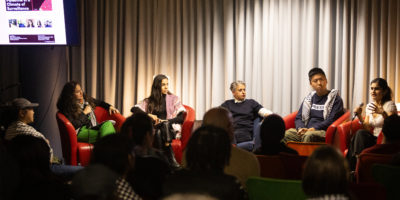By Valerie Dittrich
Ever since I was a little girl, the only thing I knew how to do was write.
I would sit in front of my parents’ desktop computer and write fiction stories for hours on end. My dad still has every document saved to his hard drive. I never finished a single one of them—and frankly, looking back, none of them were very good. But hey, I was nine. Give me a break.
My mind used to constantly buzz with ideas and I couldn’t get them out of my head until I wrote them down. Since writing was what I was best at, and I knew I wanted to do it for the rest of my life, I went with what seemed like the most palpable choice for post-secondary: journalism school.
I haven’t been able to write a fictional piece or any poetry since I first stepped on campus, even outside of class.
The aim of news writing is to make things as clear and concise as possible. Professors rewire you to cut down half your sentences and kill any adjectives or flowery language.
Journalism school meant sacrificing a lot of my creative freedom, and the better I got at formulaic news writing, the more my creative side suffered.
I found out I wasn’t the only person whose creativity suffered under their curriculum.
Second-year performance dance student Briana Clarke said she came to Ryerson as a first step in solidifying her training before hopefully moving on to New York to further pursue a career.
“I knew there were going to be a lot of classes on my feet and a lot of studio time,” she said. “But I was surprised to hear there would be a lot more academic classes as well. Especially in the first two years that I’ve been here, there’s been a lot of sitting down.”
“A lot of it is structured, the teacher tells us what to do and we do it”
Clarke mentioned that this year has been better than last, as they’ve been doing other styles instead of just ballet and jazz. But the program’s intensive hours cuts into any time Clarke has in the studio to try out new things for herself.
“The creative freedom that they give you is so limited,” she said. “Sometimes we have improvisational classes where we can move however we want, but that’s only one class a week. A lot of it is very structured, the teacher tells us what to do and we do it.”
She’s currently rehearsing for a show and has the opportunity to choreograph a routine, but notes that she still is confined to working within her professor’s expectations.
Ryerson’s dance program is known for being grueling and demanding. Clarke told me only 40 people get accepted each year and with students constantly leaving the program, her class is down by 10.
When second-year fashion student Savannah Sauriol first came to Ryerson, she prepped herself for an intensive course load and tedious work. She didn’t prepare for the lack of artistic freedom and how it would affect her confidence and creativity in class.
In first year, Sauriol had to make a textile for one of her classes. She wanted to get risky with the design, but she was worried about how far she go could go creatively with the project.
“I made it all California themed with palm trees; it was so cliché and overdone,” said Sauriol. “But I felt too scared in that class to do something crazy, I was just really unsure of myself.”
Sauriol was also not ready for how one-dimensional she felt her program was going to be in first year. She spent most of her time sewing and designing. The constant sewing left her craving to learn about the marketing and business aspects of the business. She tried to alter her experience by taking more business classes in her second year. But as she’s matured through her university experience, Sauriol’s felt more comfortable about pushing back against her curriculum.
“I think they’re getting better. A lot of teachers will say, ‘We’re going to scratch this part and give you more freedom.’ I think they’re learning.”
***
Charlie Joy, a second-year RTA student, was on my floor last year in Pitman Hall. I didn’t know him too well, but every time I walked out of my dorm for class or to grab something to eat, I would hear the low strum of guitar strings vibrate through the walls and immediately knew it was him playing.
I talked to Joy about creative roadblocks, something he’s definitely experienced as a musician. Joy’s solution is to try to work his creative projects into his assignments.
“There’s a lot of small, stupid tasks you need to do, but it’s all part of the learning process. You have to have the essential cogs of the process in your brain, like muscle memory. But it’s annoying to do it, especially when you just want to hop right into big projects.”
But even when he thinks his creative juices are flowing, Joy’s intensive course load and work schedule leaves him too exhausted to do anything about it.
“The earliest I’ll get out is midnight and the latest would be around two in the morning,” Joy said about his part-time job at a local restaurant. “Those days, especially when I’m working shifts back-to-back, I’m just in autopilot mode. There’s no time or energy to do something else. My brain is just work and sleep.”
In Sauriol’s case, creative exhaustion came from overworking a single skill. She started to lose interest.
“I don’t want to be drawing all day,” she said. “Illustration is why I went into fashion. I love it, but I’ve done it in consecutive semesters I’m sort of over it. I feel like they need to give us some sort of break so I can learn to love it again later. If you’re doing too much of one thing, you’ll fall out of love with it.”
Clarke said she tries her best to keep her creativity alive, but her jam-packed days full of high-energy dance classes and extra rehearsals, she definitely feels the fatigue. “Whenever I have free time and I’m not super tired, I try and to do stuff in my room or book a studio when I can.”
Everyone that I talked to felt like the main reason they’ve lost creative drive or energy in school was fatigue. Clarke, Joy and Sauriol all cited that balancing work and school meant not having enough time for their art and frankly, just being too tired to exercise their skills further.
***
I figured if this loss of creativity was something students even beyond my faculty felt, the people designing curriculums must have thought about it too.
Charles Falzon, the dean of Ryerson’s Faculty of Communication and Design and former chair of the RTA School of Media, spends most of his time thinking about creative curriculums. The white board that spans one of the walls in his office is marked with scribbled flowcharts representing different curriculum paths. He’s aware of the problem of repetitive work.
“I think it’s easy when you are responsible to help instruct students with the craft aspect of the creative application to get focused on that,” said Falzon. “But I think it’s really incumbent on us as educators to encourage students to take that foundation and not let it suffocate you, but actually use it as a springboard to new frontiers.”
I decided to question my program’s undergraduate director, Gavin Adamson, about whether he addressed the problem while designing the journalism curriculum.
Adamson says that while the program is concerned about dampening creativity, professors designing curriculums are restricted by university specifications.
“The university is very concerned […] about how specific learning goals are articulated and mapped out through the entire program.”
“If you’re doing too much of one thing, you’ll fall out of love with it”
I asked him if he was concerned with exhausting coursework being behind student’s lack of creativity.
Adamson says he thinks reading week breaks should help with that.
“I’m not a psychologist, but I know your mind only has so much energy and students need to take time during the holiday breaks, during reading week, after the semester ends to re-energize and totally leave this stuff alone for a couple weeks. I think they’ll find that the creativity and the energy does return.”
So, what’s the verdict? Am I just losing my mind?
Well, not exactly. Something Adamson said really resonated with me about creativity in journalism.
“I call journalism creative work, and you should too. You’re just doing a lot of it, and it’s using a lot of muscles you haven’t used before. And maybe you don’t consider it creative work. You really have to recognize that what you’re doing is creative work, although it is non-fiction, it is very creative. It is making connections for audiences and readers that is a benefit to them. It’s all your work. The research you do, the sources you talk to, the way you structure your journalism, it’s just not fiction.”
Joy feels like throughout his university career, he’s learned to rethink his relationship with creativity.
“Creativity is not something you can really hone and control, it’s more something you can learn how to co-exist with,” he said. “You can’t really control it and if you try, it’s just going to go downhill. But if you learn how to co-exist with and let it carry your flow, it’s going to work out fucking great, it’s going to be grand.”











Ron Dittrich
Very well written. Iam proud off you. Let those creative juices flow!
Dad.
Kez AD
You’re so freaking cool @valdittrich I’m your #1 fan